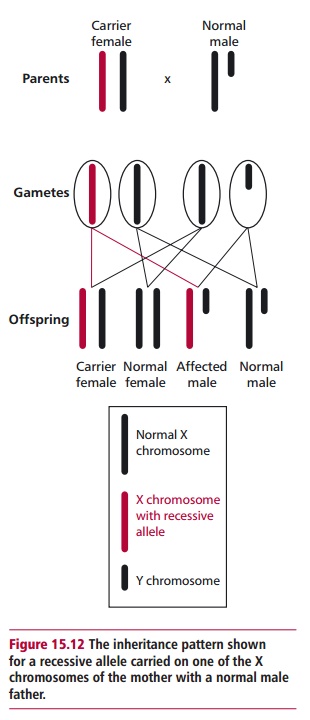Chapter: Biology of Disease: Genetic Diseases
Sex linked Genetic Diseases
SEX-LINKED GENETIC DISEASES
A number of genetic diseases are caused by defective alleles of genes of the sex (X and Y) chromosomes. The X chromosome contains many more genes than the Y, although they do have some genes in common, thus any defective (mutated) gene on the X chromosome is likely to be expressed in males (XY) but be masked in females (XX). Genetic diseases associated with the X chromosome are commonest and they are often referred to as X- or sex-linked genetic conditions. X-linked diseases can be recessive or dominant, although the former, for example hemophilia described, are the better known (Table 15.1). Given that females have two X chromosomes but males only one together with a Y chromosome, then the expression of sex-linked genes differs between females and males because many genes on the Y chromosome lack a corresponding allele on the X chromosome. Thus X-linked recessive genes are only expressed in females if there are two copies of the gene; one on each of the X chromosomes. However, for males,

there only needs to be one copy of a defective (mutated) X-linked recessive gene for the disorder to be expressed. For example, if a woman carried a mutated recessive gene on one of the X chromosomes (Figure 15.12) then statistically, 50% of her sons would inherit the defective gene and show the disorder; however, 50% of her sons would not receive the gene and would not express the condition. Similarly, half of her daughters would not receive the gene and therefore would be unable to pass it to future generations. The other half would receive the defective gene and be able to transmit it to the next generation. Like their mother, they are asymptomatic carriers of the disorder.

A common recessive X-linked condition only expressed in males is red– green color blindness. This is an inability to distinguish between red and green colors although visual acuity (keenness of vision) is normal. It is not associated with any serious complications but affected individuals may not be considered for some occupations that involve transport or the armed forces, where the ability to distinguish colors is essential. The defective gene is located on the X chromosome and males are 16 times more likely to be affected than females. Its prevalence in males is about 10%.
Related Topics